Analysis of Business Ethics, Organizational Culture, and CSR
VerifiedAdded on 2021/06/14
|17
|4527
|52
Essay
AI Summary
This essay provides a comprehensive analysis of business ethics, focusing on the failures of ethical management within organizations. It begins with an executive summary emphasizing the importance of adhering to laws and ethical standards, considering stakeholder interests, and addressing issues like multinational corporations' ethical responsibilities. The introduction sets the stage by defining business ethics and its impact on organizational priorities. The core of the essay explores how organizational cultures, such as cultures of defiance, neglect, and compliance, contribute to ethical failures. It delves into the factors influencing ethical behavior, including leadership, written codes of conduct, communication, employee training, trust, and reward systems. The essay also examines the relationship between Corporate Social Responsibility (CSR) and organizational ethics, using the case of Foxconn Technology Group to illustrate ethical challenges. It concludes with recommendations for organizations to improve ethical management, emphasizing the importance of cultural support and leadership commitment. The essay also includes an introduction and conclusion for the case study and a bibliography.
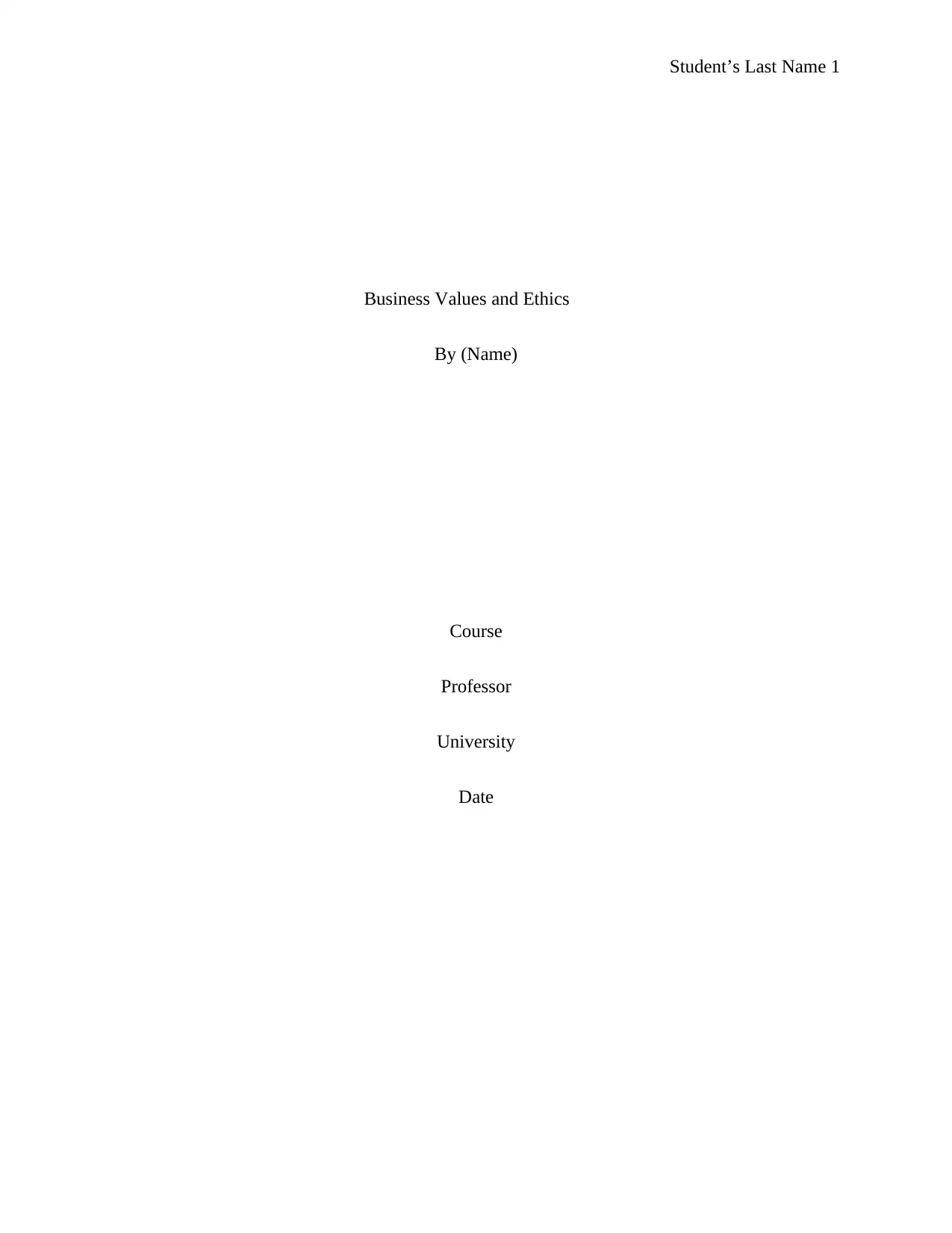
Student’s Last Name 1
Business Values and Ethics
By (Name)
Course
Professor
University
Date
Business Values and Ethics
By (Name)
Course
Professor
University
Date
Paraphrase This Document
Need a fresh take? Get an instant paraphrase of this document with our AI Paraphraser
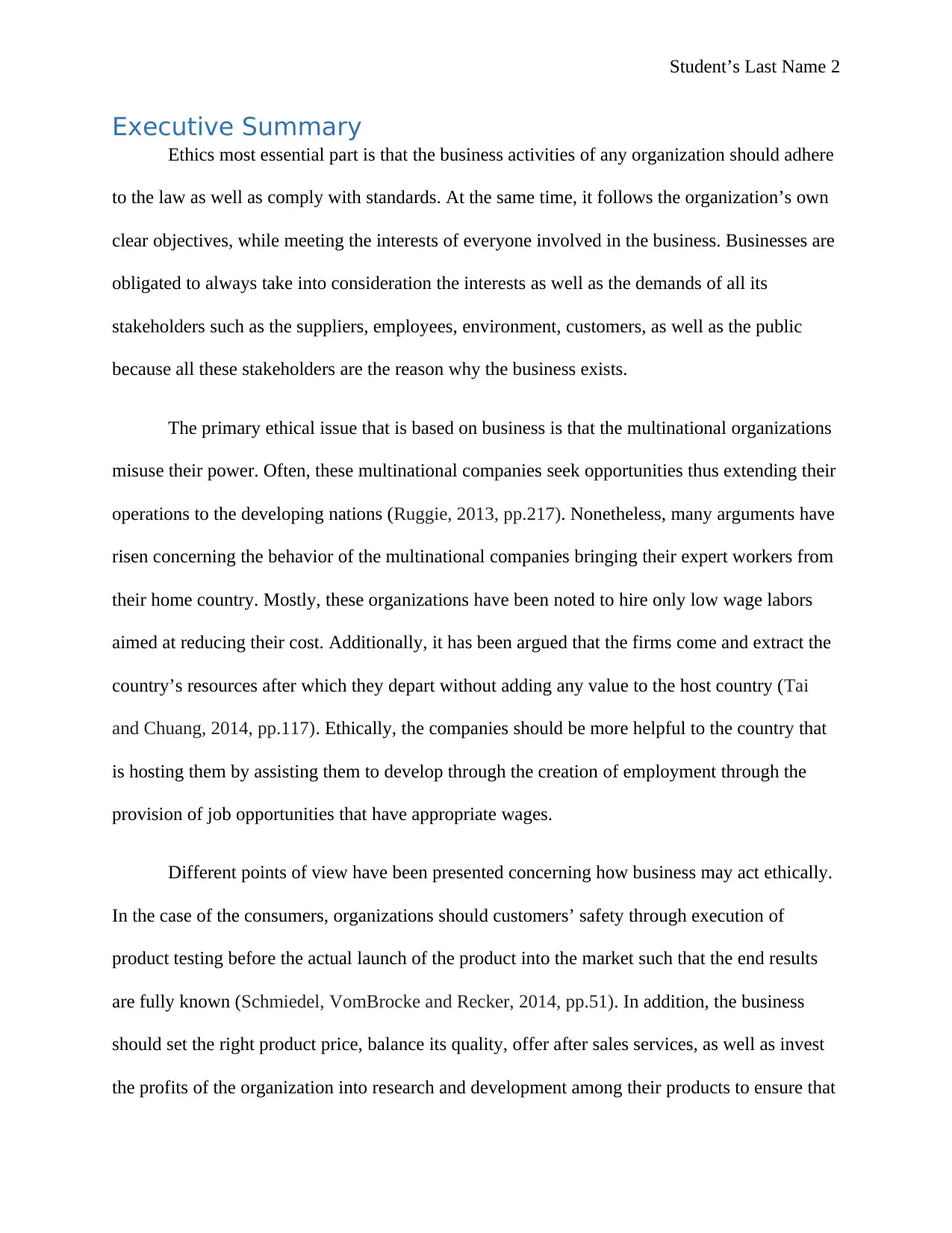
Student’s Last Name 2
Executive Summary
Ethics most essential part is that the business activities of any organization should adhere
to the law as well as comply with standards. At the same time, it follows the organization’s own
clear objectives, while meeting the interests of everyone involved in the business. Businesses are
obligated to always take into consideration the interests as well as the demands of all its
stakeholders such as the suppliers, employees, environment, customers, as well as the public
because all these stakeholders are the reason why the business exists.
The primary ethical issue that is based on business is that the multinational organizations
misuse their power. Often, these multinational companies seek opportunities thus extending their
operations to the developing nations (Ruggie, 2013, pp.217). Nonetheless, many arguments have
risen concerning the behavior of the multinational companies bringing their expert workers from
their home country. Mostly, these organizations have been noted to hire only low wage labors
aimed at reducing their cost. Additionally, it has been argued that the firms come and extract the
country’s resources after which they depart without adding any value to the host country (Tai
and Chuang, 2014, pp.117). Ethically, the companies should be more helpful to the country that
is hosting them by assisting them to develop through the creation of employment through the
provision of job opportunities that have appropriate wages.
Different points of view have been presented concerning how business may act ethically.
In the case of the consumers, organizations should customers’ safety through execution of
product testing before the actual launch of the product into the market such that the end results
are fully known (Schmiedel, VomBrocke and Recker, 2014, pp.51). In addition, the business
should set the right product price, balance its quality, offer after sales services, as well as invest
the profits of the organization into research and development among their products to ensure that
Executive Summary
Ethics most essential part is that the business activities of any organization should adhere
to the law as well as comply with standards. At the same time, it follows the organization’s own
clear objectives, while meeting the interests of everyone involved in the business. Businesses are
obligated to always take into consideration the interests as well as the demands of all its
stakeholders such as the suppliers, employees, environment, customers, as well as the public
because all these stakeholders are the reason why the business exists.
The primary ethical issue that is based on business is that the multinational organizations
misuse their power. Often, these multinational companies seek opportunities thus extending their
operations to the developing nations (Ruggie, 2013, pp.217). Nonetheless, many arguments have
risen concerning the behavior of the multinational companies bringing their expert workers from
their home country. Mostly, these organizations have been noted to hire only low wage labors
aimed at reducing their cost. Additionally, it has been argued that the firms come and extract the
country’s resources after which they depart without adding any value to the host country (Tai
and Chuang, 2014, pp.117). Ethically, the companies should be more helpful to the country that
is hosting them by assisting them to develop through the creation of employment through the
provision of job opportunities that have appropriate wages.
Different points of view have been presented concerning how business may act ethically.
In the case of the consumers, organizations should customers’ safety through execution of
product testing before the actual launch of the product into the market such that the end results
are fully known (Schmiedel, VomBrocke and Recker, 2014, pp.51). In addition, the business
should set the right product price, balance its quality, offer after sales services, as well as invest
the profits of the organization into research and development among their products to ensure that
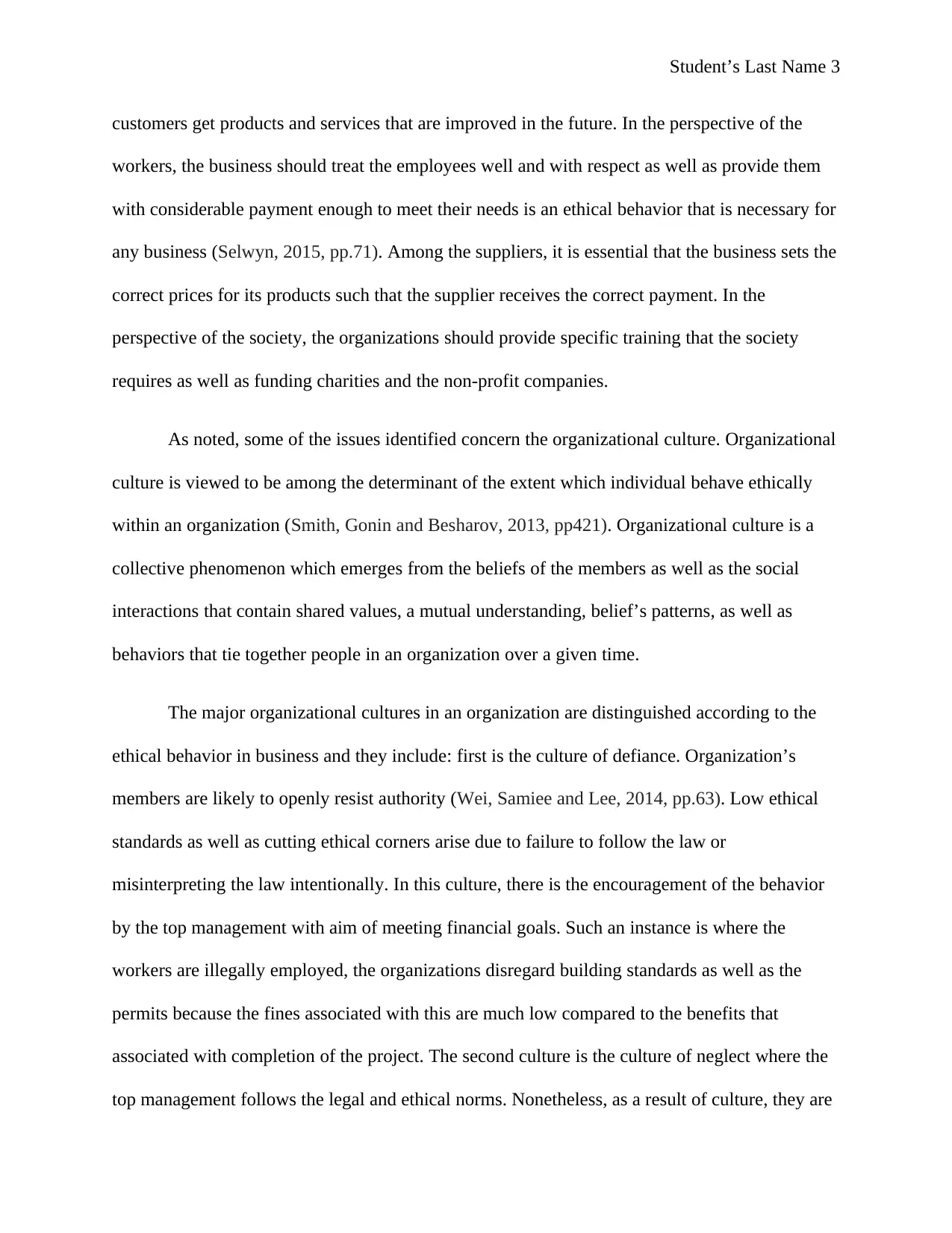
Student’s Last Name 3
customers get products and services that are improved in the future. In the perspective of the
workers, the business should treat the employees well and with respect as well as provide them
with considerable payment enough to meet their needs is an ethical behavior that is necessary for
any business (Selwyn, 2015, pp.71). Among the suppliers, it is essential that the business sets the
correct prices for its products such that the supplier receives the correct payment. In the
perspective of the society, the organizations should provide specific training that the society
requires as well as funding charities and the non-profit companies.
As noted, some of the issues identified concern the organizational culture. Organizational
culture is viewed to be among the determinant of the extent which individual behave ethically
within an organization (Smith, Gonin and Besharov, 2013, pp421). Organizational culture is a
collective phenomenon which emerges from the beliefs of the members as well as the social
interactions that contain shared values, a mutual understanding, belief’s patterns, as well as
behaviors that tie together people in an organization over a given time.
The major organizational cultures in an organization are distinguished according to the
ethical behavior in business and they include: first is the culture of defiance. Organization’s
members are likely to openly resist authority (Wei, Samiee and Lee, 2014, pp.63). Low ethical
standards as well as cutting ethical corners arise due to failure to follow the law or
misinterpreting the law intentionally. In this culture, there is the encouragement of the behavior
by the top management with aim of meeting financial goals. Such an instance is where the
workers are illegally employed, the organizations disregard building standards as well as the
permits because the fines associated with this are much low compared to the benefits that
associated with completion of the project. The second culture is the culture of neglect where the
top management follows the legal and ethical norms. Nonetheless, as a result of culture, they are
customers get products and services that are improved in the future. In the perspective of the
workers, the business should treat the employees well and with respect as well as provide them
with considerable payment enough to meet their needs is an ethical behavior that is necessary for
any business (Selwyn, 2015, pp.71). Among the suppliers, it is essential that the business sets the
correct prices for its products such that the supplier receives the correct payment. In the
perspective of the society, the organizations should provide specific training that the society
requires as well as funding charities and the non-profit companies.
As noted, some of the issues identified concern the organizational culture. Organizational
culture is viewed to be among the determinant of the extent which individual behave ethically
within an organization (Smith, Gonin and Besharov, 2013, pp421). Organizational culture is a
collective phenomenon which emerges from the beliefs of the members as well as the social
interactions that contain shared values, a mutual understanding, belief’s patterns, as well as
behaviors that tie together people in an organization over a given time.
The major organizational cultures in an organization are distinguished according to the
ethical behavior in business and they include: first is the culture of defiance. Organization’s
members are likely to openly resist authority (Wei, Samiee and Lee, 2014, pp.63). Low ethical
standards as well as cutting ethical corners arise due to failure to follow the law or
misinterpreting the law intentionally. In this culture, there is the encouragement of the behavior
by the top management with aim of meeting financial goals. Such an instance is where the
workers are illegally employed, the organizations disregard building standards as well as the
permits because the fines associated with this are much low compared to the benefits that
associated with completion of the project. The second culture is the culture of neglect where the
top management follows the legal and ethical norms. Nonetheless, as a result of culture, they are
⊘ This is a preview!⊘
Do you want full access?
Subscribe today to unlock all pages.

Trusted by 1+ million students worldwide
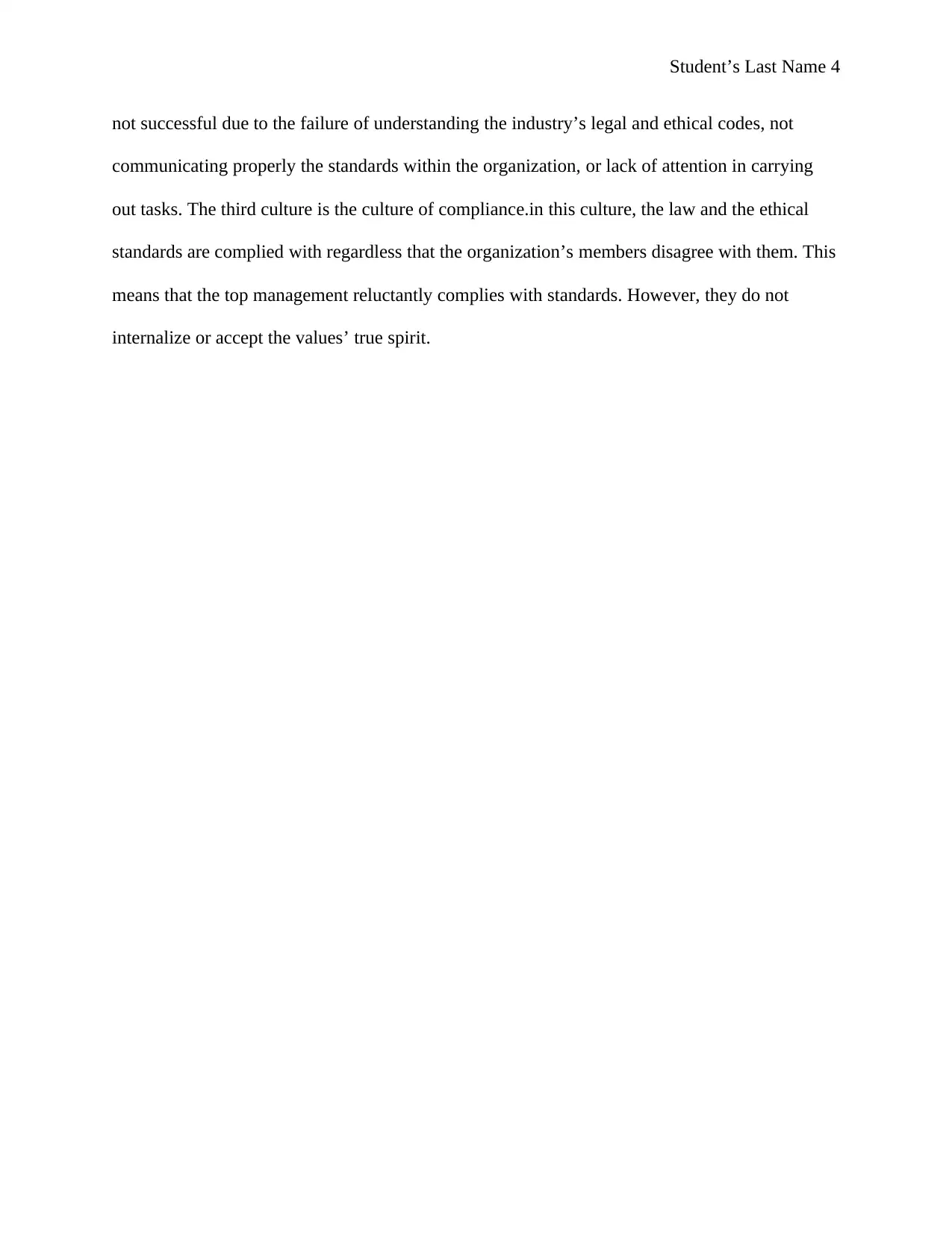
Student’s Last Name 4
not successful due to the failure of understanding the industry’s legal and ethical codes, not
communicating properly the standards within the organization, or lack of attention in carrying
out tasks. The third culture is the culture of compliance.in this culture, the law and the ethical
standards are complied with regardless that the organization’s members disagree with them. This
means that the top management reluctantly complies with standards. However, they do not
internalize or accept the values’ true spirit.
not successful due to the failure of understanding the industry’s legal and ethical codes, not
communicating properly the standards within the organization, or lack of attention in carrying
out tasks. The third culture is the culture of compliance.in this culture, the law and the ethical
standards are complied with regardless that the organization’s members disagree with them. This
means that the top management reluctantly complies with standards. However, they do not
internalize or accept the values’ true spirit.
Paraphrase This Document
Need a fresh take? Get an instant paraphrase of this document with our AI Paraphraser
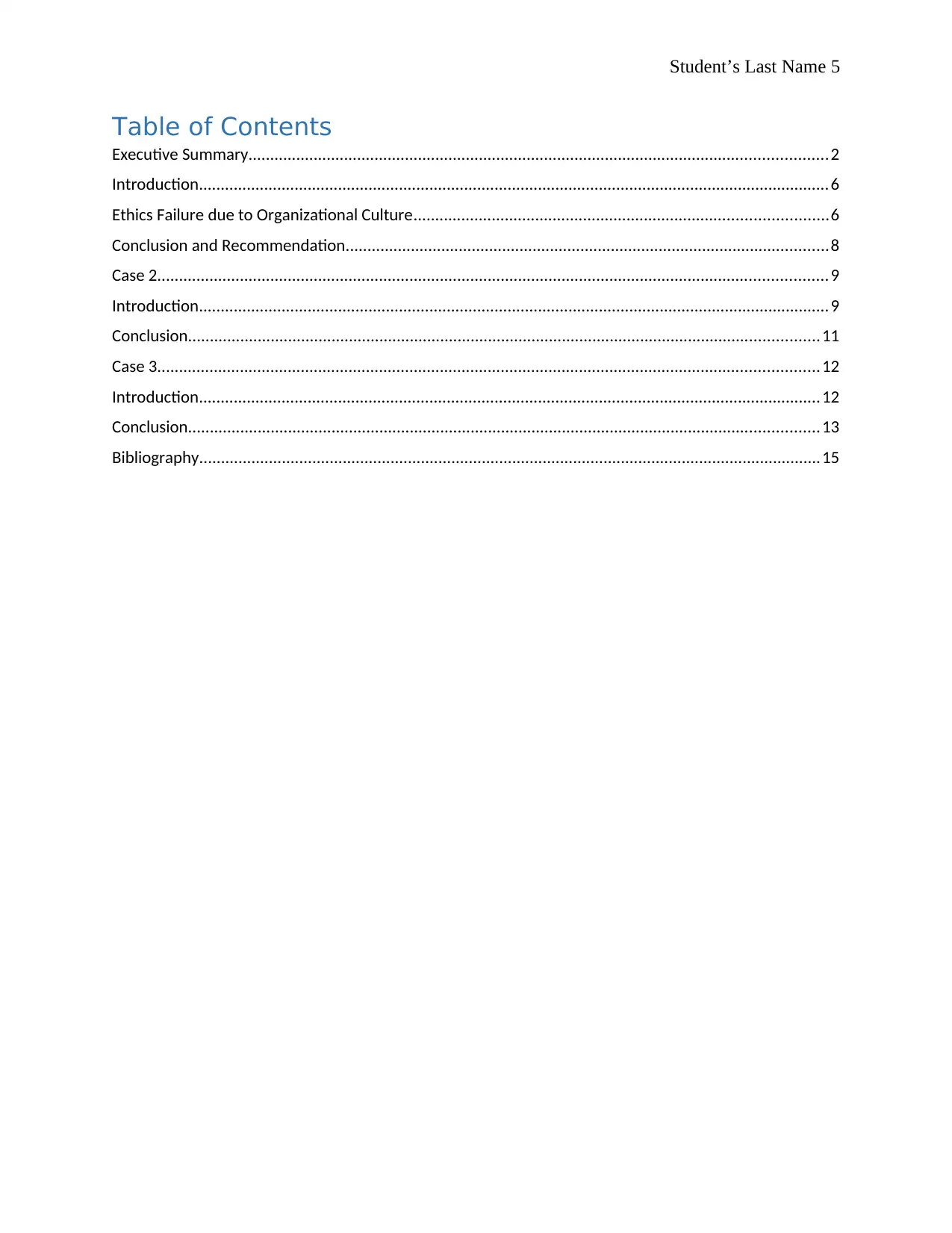
Student’s Last Name 5
Table of Contents
Executive Summary.....................................................................................................................................2
Introduction.................................................................................................................................................6
Ethics Failure due to Organizational Culture...............................................................................................6
Conclusion and Recommendation...............................................................................................................8
Case 2..........................................................................................................................................................9
Introduction.................................................................................................................................................9
Conclusion.................................................................................................................................................11
Case 3........................................................................................................................................................12
Introduction...............................................................................................................................................12
Conclusion.................................................................................................................................................13
Bibliography...............................................................................................................................................15
Table of Contents
Executive Summary.....................................................................................................................................2
Introduction.................................................................................................................................................6
Ethics Failure due to Organizational Culture...............................................................................................6
Conclusion and Recommendation...............................................................................................................8
Case 2..........................................................................................................................................................9
Introduction.................................................................................................................................................9
Conclusion.................................................................................................................................................11
Case 3........................................................................................................................................................12
Introduction...............................................................................................................................................12
Conclusion.................................................................................................................................................13
Bibliography...............................................................................................................................................15
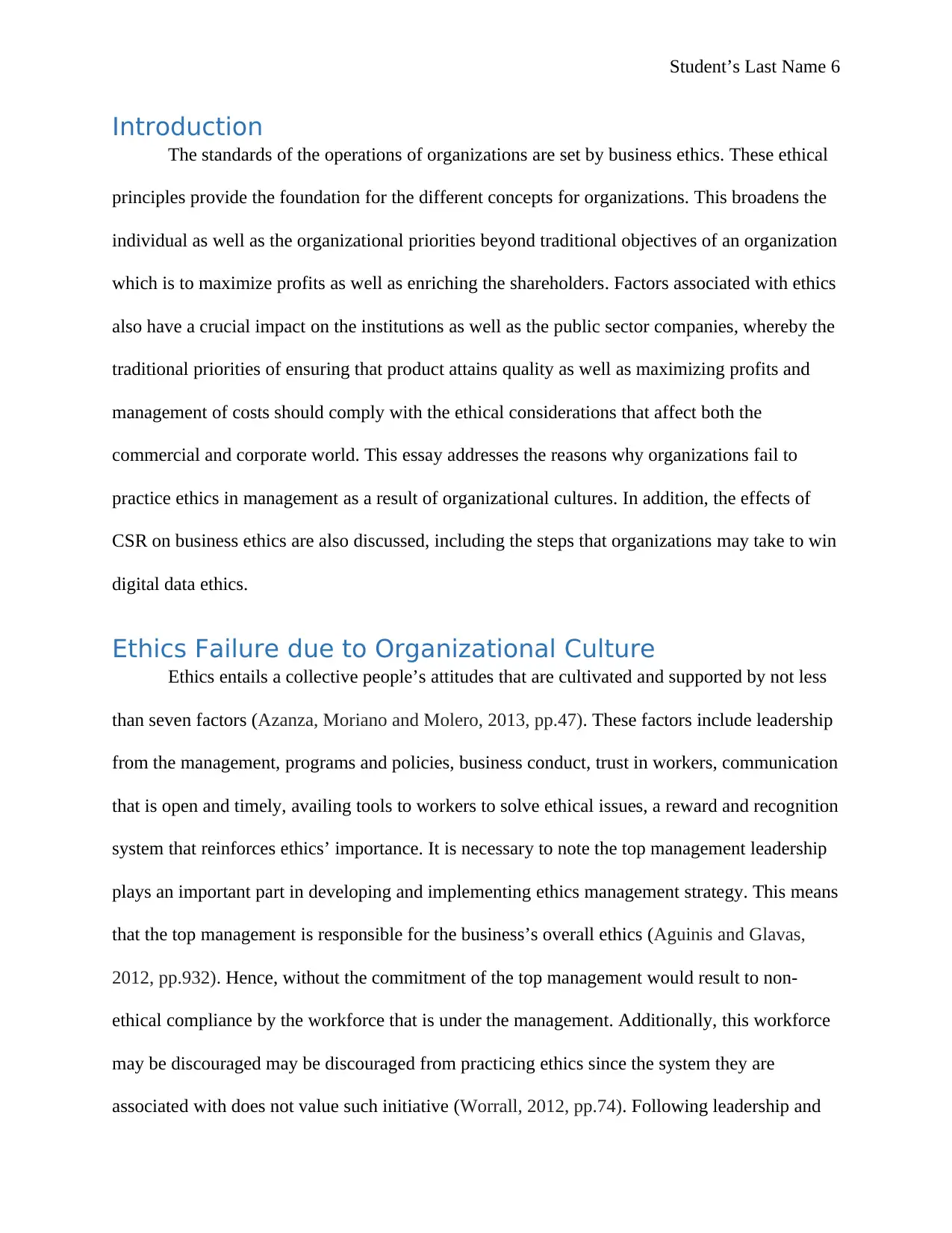
Student’s Last Name 6
Introduction
The standards of the operations of organizations are set by business ethics. These ethical
principles provide the foundation for the different concepts for organizations. This broadens the
individual as well as the organizational priorities beyond traditional objectives of an organization
which is to maximize profits as well as enriching the shareholders. Factors associated with ethics
also have a crucial impact on the institutions as well as the public sector companies, whereby the
traditional priorities of ensuring that product attains quality as well as maximizing profits and
management of costs should comply with the ethical considerations that affect both the
commercial and corporate world. This essay addresses the reasons why organizations fail to
practice ethics in management as a result of organizational cultures. In addition, the effects of
CSR on business ethics are also discussed, including the steps that organizations may take to win
digital data ethics.
Ethics Failure due to Organizational Culture
Ethics entails a collective people’s attitudes that are cultivated and supported by not less
than seven factors (Azanza, Moriano and Molero, 2013, pp.47). These factors include leadership
from the management, programs and policies, business conduct, trust in workers, communication
that is open and timely, availing tools to workers to solve ethical issues, a reward and recognition
system that reinforces ethics’ importance. It is necessary to note the top management leadership
plays an important part in developing and implementing ethics management strategy. This means
that the top management is responsible for the business’s overall ethics (Aguinis and Glavas,
2012, pp.932). Hence, without the commitment of the top management would result to non-
ethical compliance by the workforce that is under the management. Additionally, this workforce
may be discouraged may be discouraged from practicing ethics since the system they are
associated with does not value such initiative (Worrall, 2012, pp.74). Following leadership and
Introduction
The standards of the operations of organizations are set by business ethics. These ethical
principles provide the foundation for the different concepts for organizations. This broadens the
individual as well as the organizational priorities beyond traditional objectives of an organization
which is to maximize profits as well as enriching the shareholders. Factors associated with ethics
also have a crucial impact on the institutions as well as the public sector companies, whereby the
traditional priorities of ensuring that product attains quality as well as maximizing profits and
management of costs should comply with the ethical considerations that affect both the
commercial and corporate world. This essay addresses the reasons why organizations fail to
practice ethics in management as a result of organizational cultures. In addition, the effects of
CSR on business ethics are also discussed, including the steps that organizations may take to win
digital data ethics.
Ethics Failure due to Organizational Culture
Ethics entails a collective people’s attitudes that are cultivated and supported by not less
than seven factors (Azanza, Moriano and Molero, 2013, pp.47). These factors include leadership
from the management, programs and policies, business conduct, trust in workers, communication
that is open and timely, availing tools to workers to solve ethical issues, a reward and recognition
system that reinforces ethics’ importance. It is necessary to note the top management leadership
plays an important part in developing and implementing ethics management strategy. This means
that the top management is responsible for the business’s overall ethics (Aguinis and Glavas,
2012, pp.932). Hence, without the commitment of the top management would result to non-
ethical compliance by the workforce that is under the management. Additionally, this workforce
may be discouraged may be discouraged from practicing ethics since the system they are
associated with does not value such initiative (Worrall, 2012, pp.74). Following leadership and
⊘ This is a preview!⊘
Do you want full access?
Subscribe today to unlock all pages.

Trusted by 1+ million students worldwide
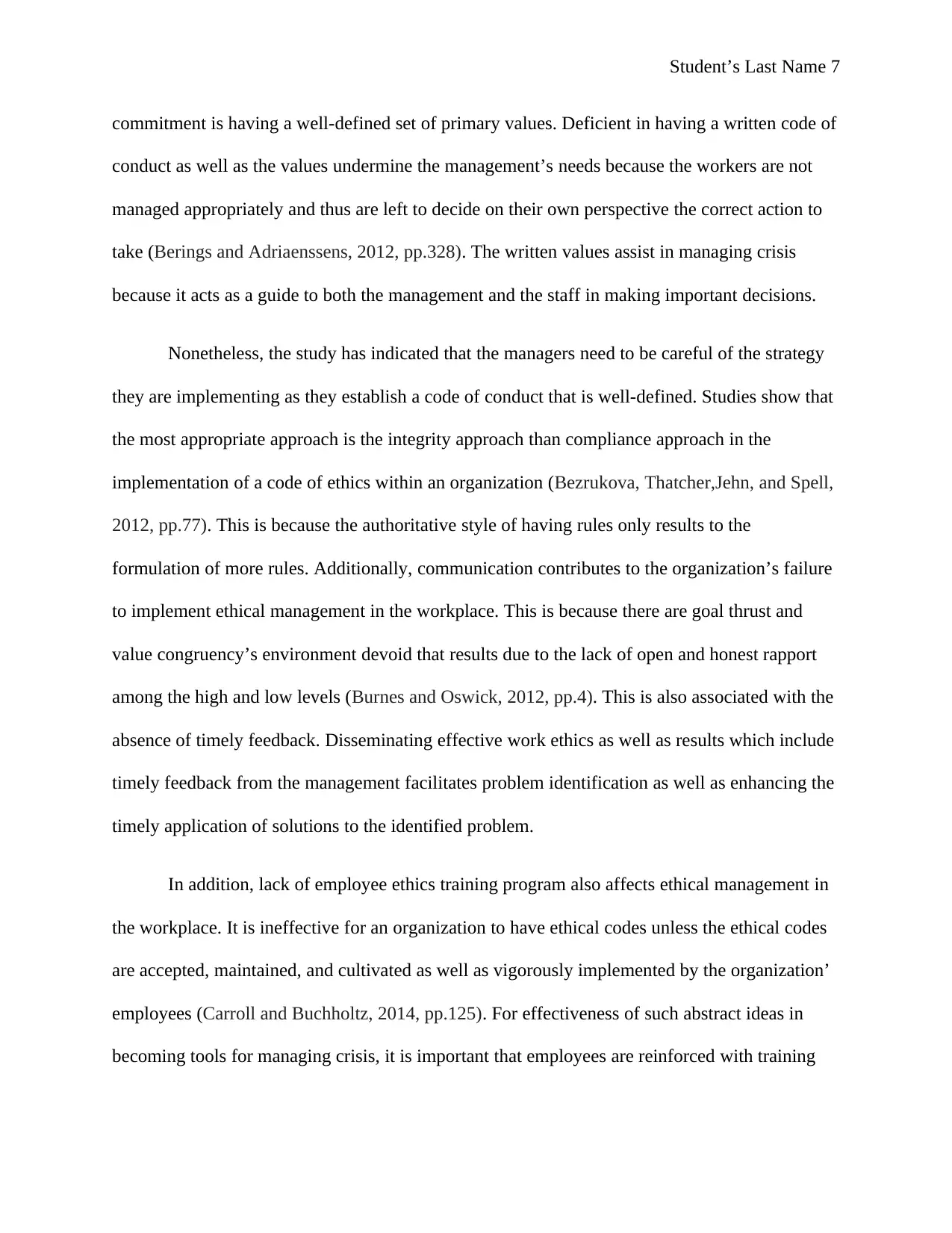
Student’s Last Name 7
commitment is having a well-defined set of primary values. Deficient in having a written code of
conduct as well as the values undermine the management’s needs because the workers are not
managed appropriately and thus are left to decide on their own perspective the correct action to
take (Berings and Adriaenssens, 2012, pp.328). The written values assist in managing crisis
because it acts as a guide to both the management and the staff in making important decisions.
Nonetheless, the study has indicated that the managers need to be careful of the strategy
they are implementing as they establish a code of conduct that is well-defined. Studies show that
the most appropriate approach is the integrity approach than compliance approach in the
implementation of a code of ethics within an organization (Bezrukova, Thatcher,Jehn, and Spell,
2012, pp.77). This is because the authoritative style of having rules only results to the
formulation of more rules. Additionally, communication contributes to the organization’s failure
to implement ethical management in the workplace. This is because there are goal thrust and
value congruency’s environment devoid that results due to the lack of open and honest rapport
among the high and low levels (Burnes and Oswick, 2012, pp.4). This is also associated with the
absence of timely feedback. Disseminating effective work ethics as well as results which include
timely feedback from the management facilitates problem identification as well as enhancing the
timely application of solutions to the identified problem.
In addition, lack of employee ethics training program also affects ethical management in
the workplace. It is ineffective for an organization to have ethical codes unless the ethical codes
are accepted, maintained, and cultivated as well as vigorously implemented by the organization’
employees (Carroll and Buchholtz, 2014, pp.125). For effectiveness of such abstract ideas in
becoming tools for managing crisis, it is important that employees are reinforced with training
commitment is having a well-defined set of primary values. Deficient in having a written code of
conduct as well as the values undermine the management’s needs because the workers are not
managed appropriately and thus are left to decide on their own perspective the correct action to
take (Berings and Adriaenssens, 2012, pp.328). The written values assist in managing crisis
because it acts as a guide to both the management and the staff in making important decisions.
Nonetheless, the study has indicated that the managers need to be careful of the strategy
they are implementing as they establish a code of conduct that is well-defined. Studies show that
the most appropriate approach is the integrity approach than compliance approach in the
implementation of a code of ethics within an organization (Bezrukova, Thatcher,Jehn, and Spell,
2012, pp.77). This is because the authoritative style of having rules only results to the
formulation of more rules. Additionally, communication contributes to the organization’s failure
to implement ethical management in the workplace. This is because there are goal thrust and
value congruency’s environment devoid that results due to the lack of open and honest rapport
among the high and low levels (Burnes and Oswick, 2012, pp.4). This is also associated with the
absence of timely feedback. Disseminating effective work ethics as well as results which include
timely feedback from the management facilitates problem identification as well as enhancing the
timely application of solutions to the identified problem.
In addition, lack of employee ethics training program also affects ethical management in
the workplace. It is ineffective for an organization to have ethical codes unless the ethical codes
are accepted, maintained, and cultivated as well as vigorously implemented by the organization’
employees (Carroll and Buchholtz, 2014, pp.125). For effectiveness of such abstract ideas in
becoming tools for managing crisis, it is important that employees are reinforced with training
Paraphrase This Document
Need a fresh take? Get an instant paraphrase of this document with our AI Paraphraser
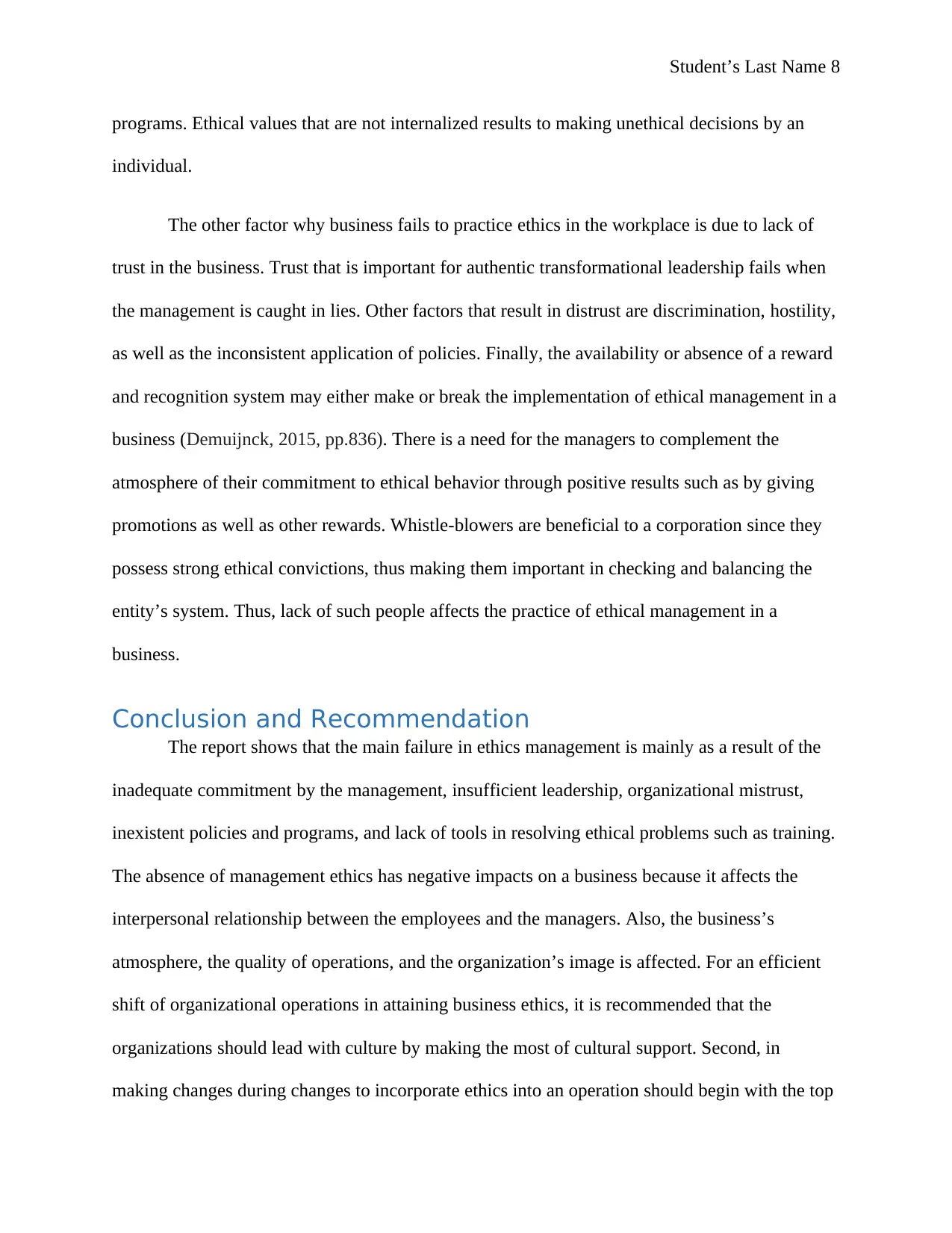
Student’s Last Name 8
programs. Ethical values that are not internalized results to making unethical decisions by an
individual.
The other factor why business fails to practice ethics in the workplace is due to lack of
trust in the business. Trust that is important for authentic transformational leadership fails when
the management is caught in lies. Other factors that result in distrust are discrimination, hostility,
as well as the inconsistent application of policies. Finally, the availability or absence of a reward
and recognition system may either make or break the implementation of ethical management in a
business (Demuijnck, 2015, pp.836). There is a need for the managers to complement the
atmosphere of their commitment to ethical behavior through positive results such as by giving
promotions as well as other rewards. Whistle-blowers are beneficial to a corporation since they
possess strong ethical convictions, thus making them important in checking and balancing the
entity’s system. Thus, lack of such people affects the practice of ethical management in a
business.
Conclusion and Recommendation
The report shows that the main failure in ethics management is mainly as a result of the
inadequate commitment by the management, insufficient leadership, organizational mistrust,
inexistent policies and programs, and lack of tools in resolving ethical problems such as training.
The absence of management ethics has negative impacts on a business because it affects the
interpersonal relationship between the employees and the managers. Also, the business’s
atmosphere, the quality of operations, and the organization’s image is affected. For an efficient
shift of organizational operations in attaining business ethics, it is recommended that the
organizations should lead with culture by making the most of cultural support. Second, in
making changes during changes to incorporate ethics into an operation should begin with the top
programs. Ethical values that are not internalized results to making unethical decisions by an
individual.
The other factor why business fails to practice ethics in the workplace is due to lack of
trust in the business. Trust that is important for authentic transformational leadership fails when
the management is caught in lies. Other factors that result in distrust are discrimination, hostility,
as well as the inconsistent application of policies. Finally, the availability or absence of a reward
and recognition system may either make or break the implementation of ethical management in a
business (Demuijnck, 2015, pp.836). There is a need for the managers to complement the
atmosphere of their commitment to ethical behavior through positive results such as by giving
promotions as well as other rewards. Whistle-blowers are beneficial to a corporation since they
possess strong ethical convictions, thus making them important in checking and balancing the
entity’s system. Thus, lack of such people affects the practice of ethical management in a
business.
Conclusion and Recommendation
The report shows that the main failure in ethics management is mainly as a result of the
inadequate commitment by the management, insufficient leadership, organizational mistrust,
inexistent policies and programs, and lack of tools in resolving ethical problems such as training.
The absence of management ethics has negative impacts on a business because it affects the
interpersonal relationship between the employees and the managers. Also, the business’s
atmosphere, the quality of operations, and the organization’s image is affected. For an efficient
shift of organizational operations in attaining business ethics, it is recommended that the
organizations should lead with culture by making the most of cultural support. Second, in
making changes during changes to incorporate ethics into an operation should begin with the top
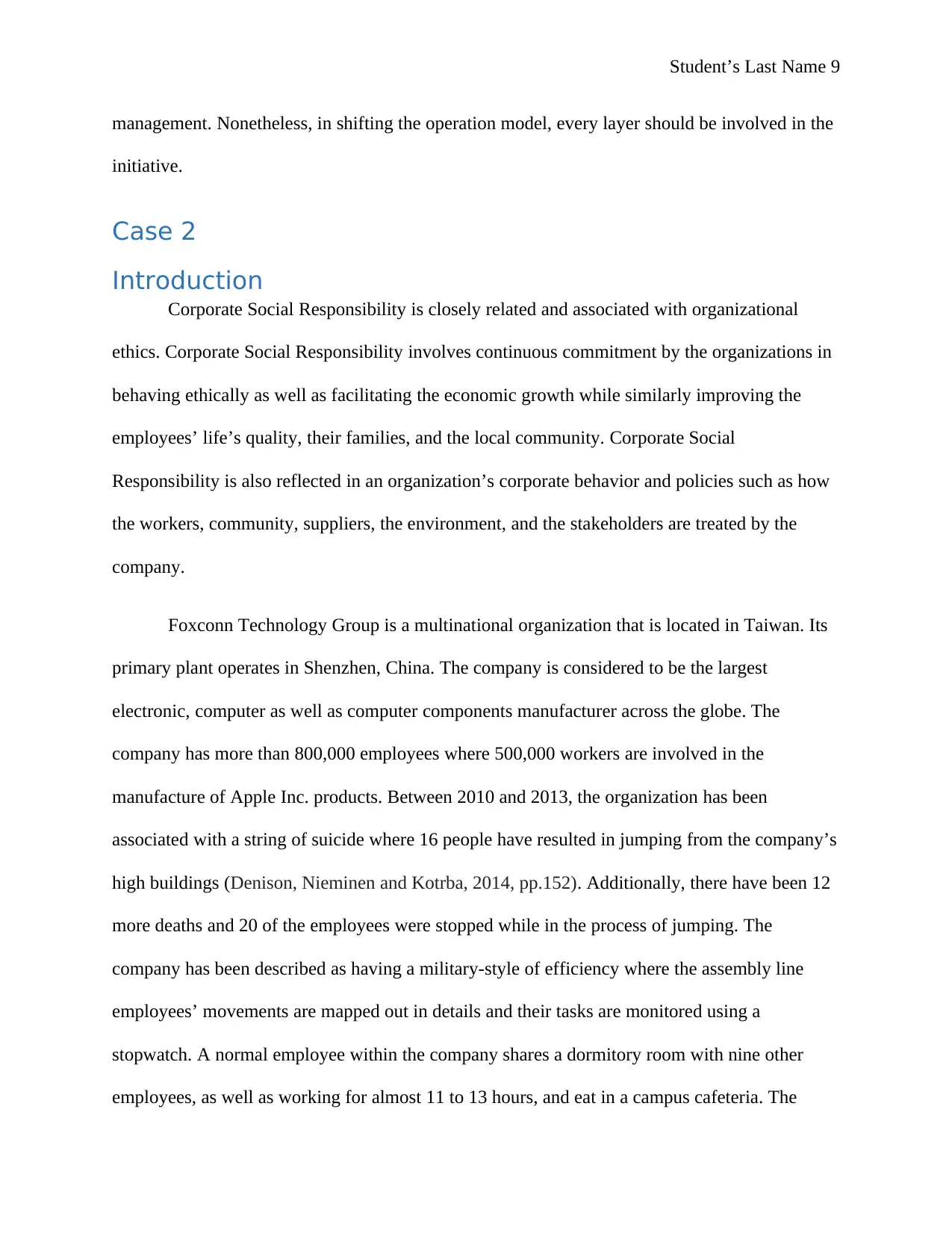
Student’s Last Name 9
management. Nonetheless, in shifting the operation model, every layer should be involved in the
initiative.
Case 2
Introduction
Corporate Social Responsibility is closely related and associated with organizational
ethics. Corporate Social Responsibility involves continuous commitment by the organizations in
behaving ethically as well as facilitating the economic growth while similarly improving the
employees’ life’s quality, their families, and the local community. Corporate Social
Responsibility is also reflected in an organization’s corporate behavior and policies such as how
the workers, community, suppliers, the environment, and the stakeholders are treated by the
company.
Foxconn Technology Group is a multinational organization that is located in Taiwan. Its
primary plant operates in Shenzhen, China. The company is considered to be the largest
electronic, computer as well as computer components manufacturer across the globe. The
company has more than 800,000 employees where 500,000 workers are involved in the
manufacture of Apple Inc. products. Between 2010 and 2013, the organization has been
associated with a string of suicide where 16 people have resulted in jumping from the company’s
high buildings (Denison, Nieminen and Kotrba, 2014, pp.152). Additionally, there have been 12
more deaths and 20 of the employees were stopped while in the process of jumping. The
company has been described as having a military-style of efficiency where the assembly line
employees’ movements are mapped out in details and their tasks are monitored using a
stopwatch. A normal employee within the company shares a dormitory room with nine other
employees, as well as working for almost 11 to 13 hours, and eat in a campus cafeteria. The
management. Nonetheless, in shifting the operation model, every layer should be involved in the
initiative.
Case 2
Introduction
Corporate Social Responsibility is closely related and associated with organizational
ethics. Corporate Social Responsibility involves continuous commitment by the organizations in
behaving ethically as well as facilitating the economic growth while similarly improving the
employees’ life’s quality, their families, and the local community. Corporate Social
Responsibility is also reflected in an organization’s corporate behavior and policies such as how
the workers, community, suppliers, the environment, and the stakeholders are treated by the
company.
Foxconn Technology Group is a multinational organization that is located in Taiwan. Its
primary plant operates in Shenzhen, China. The company is considered to be the largest
electronic, computer as well as computer components manufacturer across the globe. The
company has more than 800,000 employees where 500,000 workers are involved in the
manufacture of Apple Inc. products. Between 2010 and 2013, the organization has been
associated with a string of suicide where 16 people have resulted in jumping from the company’s
high buildings (Denison, Nieminen and Kotrba, 2014, pp.152). Additionally, there have been 12
more deaths and 20 of the employees were stopped while in the process of jumping. The
company has been described as having a military-style of efficiency where the assembly line
employees’ movements are mapped out in details and their tasks are monitored using a
stopwatch. A normal employee within the company shares a dormitory room with nine other
employees, as well as working for almost 11 to 13 hours, and eat in a campus cafeteria. The
⊘ This is a preview!⊘
Do you want full access?
Subscribe today to unlock all pages.

Trusted by 1+ million students worldwide
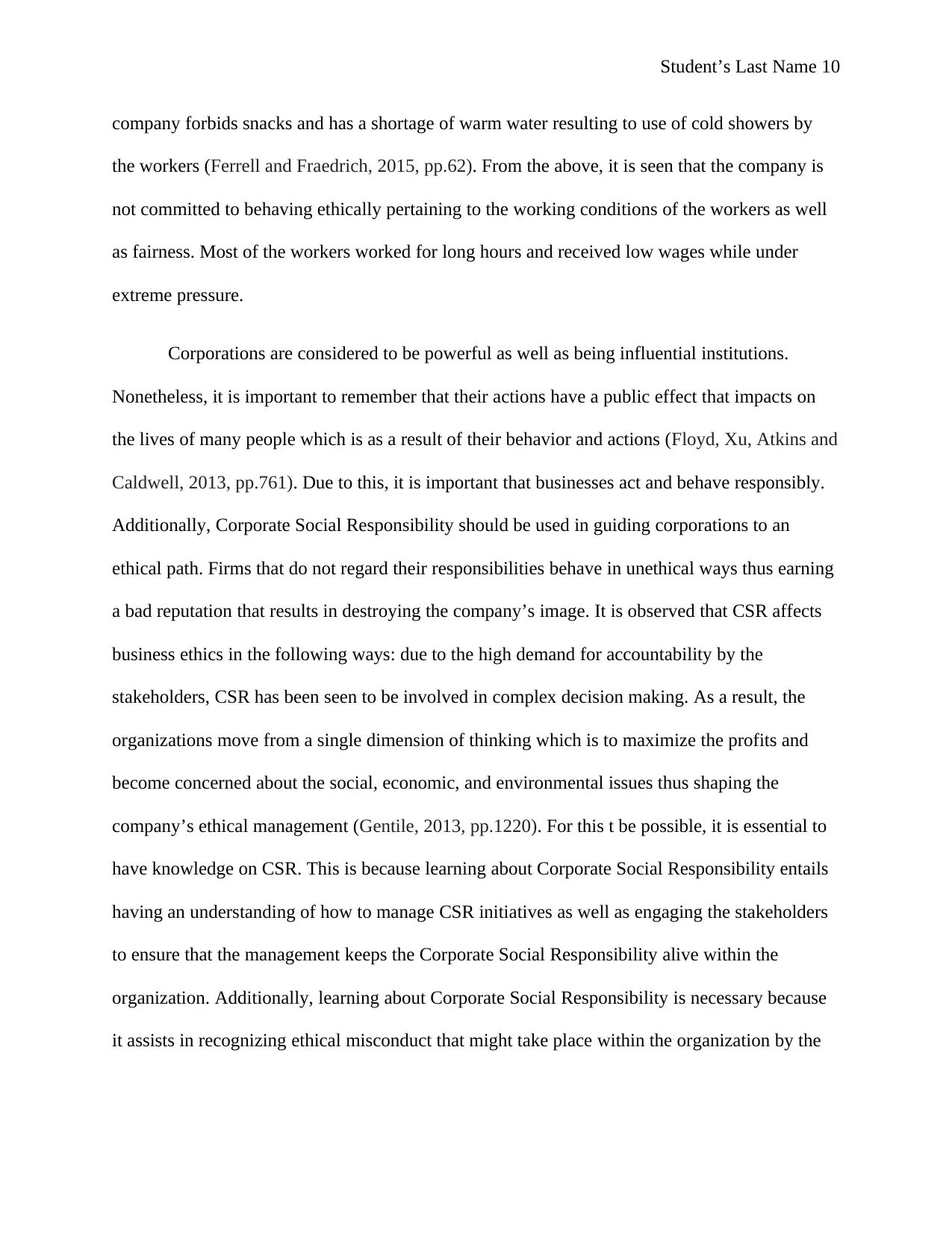
Student’s Last Name 10
company forbids snacks and has a shortage of warm water resulting to use of cold showers by
the workers (Ferrell and Fraedrich, 2015, pp.62). From the above, it is seen that the company is
not committed to behaving ethically pertaining to the working conditions of the workers as well
as fairness. Most of the workers worked for long hours and received low wages while under
extreme pressure.
Corporations are considered to be powerful as well as being influential institutions.
Nonetheless, it is important to remember that their actions have a public effect that impacts on
the lives of many people which is as a result of their behavior and actions (Floyd, Xu, Atkins and
Caldwell, 2013, pp.761). Due to this, it is important that businesses act and behave responsibly.
Additionally, Corporate Social Responsibility should be used in guiding corporations to an
ethical path. Firms that do not regard their responsibilities behave in unethical ways thus earning
a bad reputation that results in destroying the company’s image. It is observed that CSR affects
business ethics in the following ways: due to the high demand for accountability by the
stakeholders, CSR has been seen to be involved in complex decision making. As a result, the
organizations move from a single dimension of thinking which is to maximize the profits and
become concerned about the social, economic, and environmental issues thus shaping the
company’s ethical management (Gentile, 2013, pp.1220). For this t be possible, it is essential to
have knowledge on CSR. This is because learning about Corporate Social Responsibility entails
having an understanding of how to manage CSR initiatives as well as engaging the stakeholders
to ensure that the management keeps the Corporate Social Responsibility alive within the
organization. Additionally, learning about Corporate Social Responsibility is necessary because
it assists in recognizing ethical misconduct that might take place within the organization by the
company forbids snacks and has a shortage of warm water resulting to use of cold showers by
the workers (Ferrell and Fraedrich, 2015, pp.62). From the above, it is seen that the company is
not committed to behaving ethically pertaining to the working conditions of the workers as well
as fairness. Most of the workers worked for long hours and received low wages while under
extreme pressure.
Corporations are considered to be powerful as well as being influential institutions.
Nonetheless, it is important to remember that their actions have a public effect that impacts on
the lives of many people which is as a result of their behavior and actions (Floyd, Xu, Atkins and
Caldwell, 2013, pp.761). Due to this, it is important that businesses act and behave responsibly.
Additionally, Corporate Social Responsibility should be used in guiding corporations to an
ethical path. Firms that do not regard their responsibilities behave in unethical ways thus earning
a bad reputation that results in destroying the company’s image. It is observed that CSR affects
business ethics in the following ways: due to the high demand for accountability by the
stakeholders, CSR has been seen to be involved in complex decision making. As a result, the
organizations move from a single dimension of thinking which is to maximize the profits and
become concerned about the social, economic, and environmental issues thus shaping the
company’s ethical management (Gentile, 2013, pp.1220). For this t be possible, it is essential to
have knowledge on CSR. This is because learning about Corporate Social Responsibility entails
having an understanding of how to manage CSR initiatives as well as engaging the stakeholders
to ensure that the management keeps the Corporate Social Responsibility alive within the
organization. Additionally, learning about Corporate Social Responsibility is necessary because
it assists in recognizing ethical misconduct that might take place within the organization by the
Paraphrase This Document
Need a fresh take? Get an instant paraphrase of this document with our AI Paraphraser
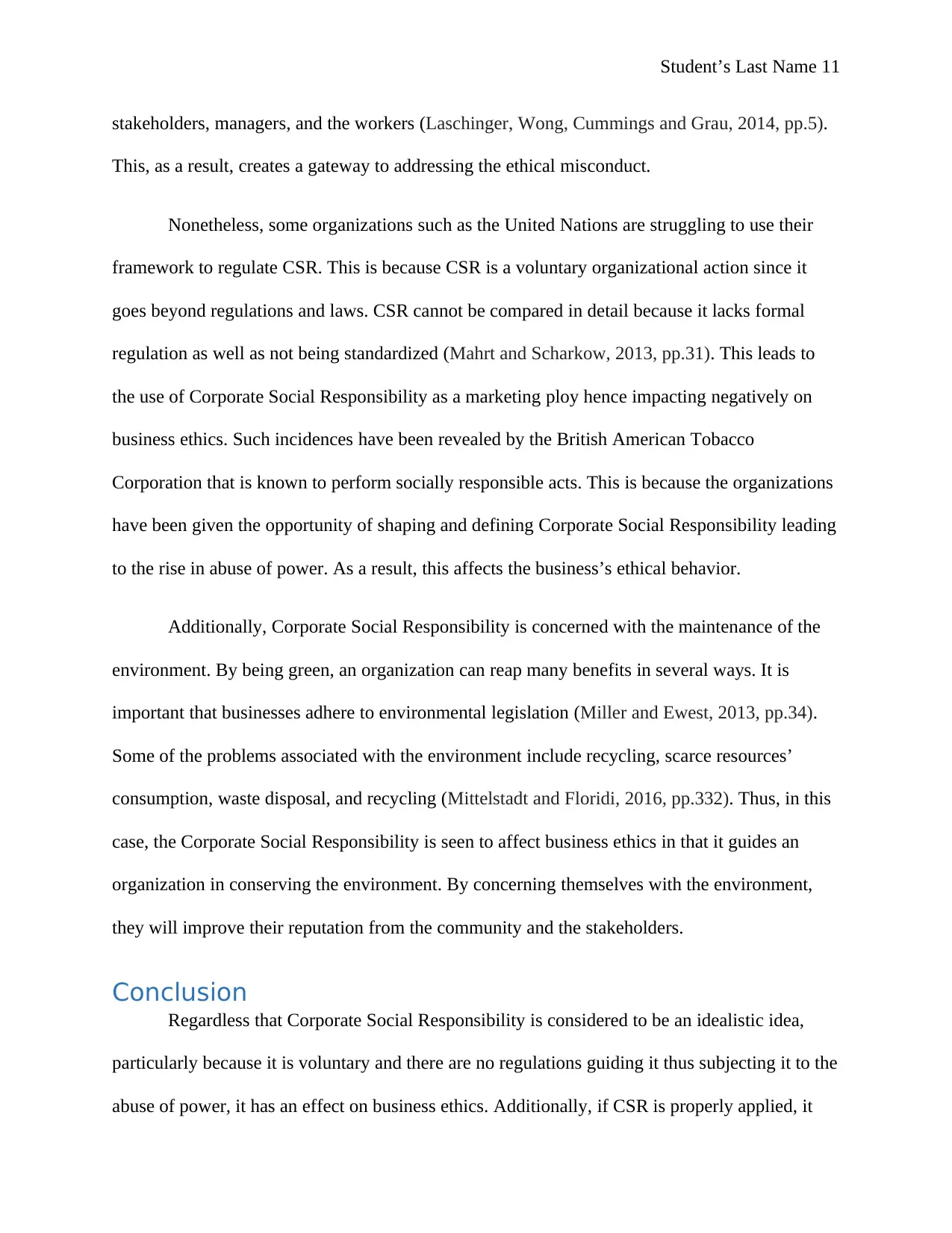
Student’s Last Name 11
stakeholders, managers, and the workers (Laschinger, Wong, Cummings and Grau, 2014, pp.5).
This, as a result, creates a gateway to addressing the ethical misconduct.
Nonetheless, some organizations such as the United Nations are struggling to use their
framework to regulate CSR. This is because CSR is a voluntary organizational action since it
goes beyond regulations and laws. CSR cannot be compared in detail because it lacks formal
regulation as well as not being standardized (Mahrt and Scharkow, 2013, pp.31). This leads to
the use of Corporate Social Responsibility as a marketing ploy hence impacting negatively on
business ethics. Such incidences have been revealed by the British American Tobacco
Corporation that is known to perform socially responsible acts. This is because the organizations
have been given the opportunity of shaping and defining Corporate Social Responsibility leading
to the rise in abuse of power. As a result, this affects the business’s ethical behavior.
Additionally, Corporate Social Responsibility is concerned with the maintenance of the
environment. By being green, an organization can reap many benefits in several ways. It is
important that businesses adhere to environmental legislation (Miller and Ewest, 2013, pp.34).
Some of the problems associated with the environment include recycling, scarce resources’
consumption, waste disposal, and recycling (Mittelstadt and Floridi, 2016, pp.332). Thus, in this
case, the Corporate Social Responsibility is seen to affect business ethics in that it guides an
organization in conserving the environment. By concerning themselves with the environment,
they will improve their reputation from the community and the stakeholders.
Conclusion
Regardless that Corporate Social Responsibility is considered to be an idealistic idea,
particularly because it is voluntary and there are no regulations guiding it thus subjecting it to the
abuse of power, it has an effect on business ethics. Additionally, if CSR is properly applied, it
stakeholders, managers, and the workers (Laschinger, Wong, Cummings and Grau, 2014, pp.5).
This, as a result, creates a gateway to addressing the ethical misconduct.
Nonetheless, some organizations such as the United Nations are struggling to use their
framework to regulate CSR. This is because CSR is a voluntary organizational action since it
goes beyond regulations and laws. CSR cannot be compared in detail because it lacks formal
regulation as well as not being standardized (Mahrt and Scharkow, 2013, pp.31). This leads to
the use of Corporate Social Responsibility as a marketing ploy hence impacting negatively on
business ethics. Such incidences have been revealed by the British American Tobacco
Corporation that is known to perform socially responsible acts. This is because the organizations
have been given the opportunity of shaping and defining Corporate Social Responsibility leading
to the rise in abuse of power. As a result, this affects the business’s ethical behavior.
Additionally, Corporate Social Responsibility is concerned with the maintenance of the
environment. By being green, an organization can reap many benefits in several ways. It is
important that businesses adhere to environmental legislation (Miller and Ewest, 2013, pp.34).
Some of the problems associated with the environment include recycling, scarce resources’
consumption, waste disposal, and recycling (Mittelstadt and Floridi, 2016, pp.332). Thus, in this
case, the Corporate Social Responsibility is seen to affect business ethics in that it guides an
organization in conserving the environment. By concerning themselves with the environment,
they will improve their reputation from the community and the stakeholders.
Conclusion
Regardless that Corporate Social Responsibility is considered to be an idealistic idea,
particularly because it is voluntary and there are no regulations guiding it thus subjecting it to the
abuse of power, it has an effect on business ethics. Additionally, if CSR is properly applied, it
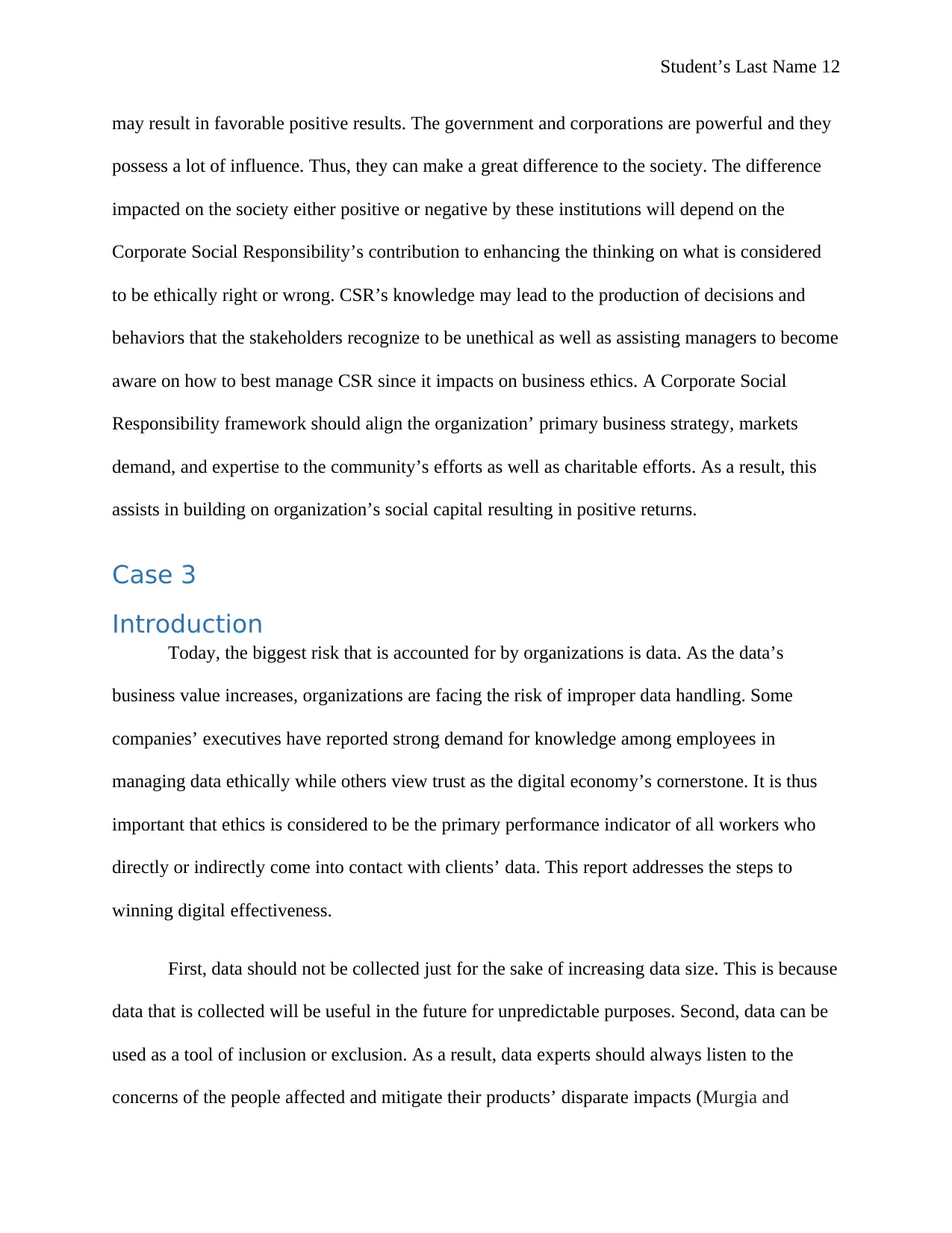
Student’s Last Name 12
may result in favorable positive results. The government and corporations are powerful and they
possess a lot of influence. Thus, they can make a great difference to the society. The difference
impacted on the society either positive or negative by these institutions will depend on the
Corporate Social Responsibility’s contribution to enhancing the thinking on what is considered
to be ethically right or wrong. CSR’s knowledge may lead to the production of decisions and
behaviors that the stakeholders recognize to be unethical as well as assisting managers to become
aware on how to best manage CSR since it impacts on business ethics. A Corporate Social
Responsibility framework should align the organization’ primary business strategy, markets
demand, and expertise to the community’s efforts as well as charitable efforts. As a result, this
assists in building on organization’s social capital resulting in positive returns.
Case 3
Introduction
Today, the biggest risk that is accounted for by organizations is data. As the data’s
business value increases, organizations are facing the risk of improper data handling. Some
companies’ executives have reported strong demand for knowledge among employees in
managing data ethically while others view trust as the digital economy’s cornerstone. It is thus
important that ethics is considered to be the primary performance indicator of all workers who
directly or indirectly come into contact with clients’ data. This report addresses the steps to
winning digital effectiveness.
First, data should not be collected just for the sake of increasing data size. This is because
data that is collected will be useful in the future for unpredictable purposes. Second, data can be
used as a tool of inclusion or exclusion. As a result, data experts should always listen to the
concerns of the people affected and mitigate their products’ disparate impacts (Murgia and
may result in favorable positive results. The government and corporations are powerful and they
possess a lot of influence. Thus, they can make a great difference to the society. The difference
impacted on the society either positive or negative by these institutions will depend on the
Corporate Social Responsibility’s contribution to enhancing the thinking on what is considered
to be ethically right or wrong. CSR’s knowledge may lead to the production of decisions and
behaviors that the stakeholders recognize to be unethical as well as assisting managers to become
aware on how to best manage CSR since it impacts on business ethics. A Corporate Social
Responsibility framework should align the organization’ primary business strategy, markets
demand, and expertise to the community’s efforts as well as charitable efforts. As a result, this
assists in building on organization’s social capital resulting in positive returns.
Case 3
Introduction
Today, the biggest risk that is accounted for by organizations is data. As the data’s
business value increases, organizations are facing the risk of improper data handling. Some
companies’ executives have reported strong demand for knowledge among employees in
managing data ethically while others view trust as the digital economy’s cornerstone. It is thus
important that ethics is considered to be the primary performance indicator of all workers who
directly or indirectly come into contact with clients’ data. This report addresses the steps to
winning digital effectiveness.
First, data should not be collected just for the sake of increasing data size. This is because
data that is collected will be useful in the future for unpredictable purposes. Second, data can be
used as a tool of inclusion or exclusion. As a result, data experts should always listen to the
concerns of the people affected and mitigate their products’ disparate impacts (Murgia and
⊘ This is a preview!⊘
Do you want full access?
Subscribe today to unlock all pages.

Trusted by 1+ million students worldwide
1 out of 17
Related Documents
Your All-in-One AI-Powered Toolkit for Academic Success.
+13062052269
info@desklib.com
Available 24*7 on WhatsApp / Email
![[object Object]](/_next/static/media/star-bottom.7253800d.svg)
Unlock your academic potential
Copyright © 2020–2025 A2Z Services. All Rights Reserved. Developed and managed by ZUCOL.





